Serving 266 students in grades 9-12, Unity Center For Urban Technologies ranks in the top 50% of all schools in New York for overall test scores (math proficiency is top 10%, and reading proficiency is top 10%).
The percentage of students achieving proficiency in math is 85-89% (which is higher than the New York state average of 46%). The percentage of students achieving proficiency in reading/language arts is 21-39% (which is lower than the New York state average of 49%).
The student:teacher ratio of 13:1 is higher than the New York state level of 11:1.
Minority enrollment is 94% of the student body (majority Hispanic), which is higher than the New York state average of 60% (majority Hispanic).
Quick Stats (2025)
- Grades: 9-12
- Enrollment: 266 students
- Student:Teacher Ratio: 13:1
- Minority Enrollment: 94%
- Graduation Rate: ≥90% (Top 50% in NY)
- Overall Testing Rank: Top 50%
- Math Proficiency: 85-89% (Top 10%)
- Reading Proficiency: 21-39% (Btm 50%)
- Science Proficiency: ≥95% (Top 5%)
- Source: National Center for Education Statistics (NCES), NY Dept. of Education
Top Rankings
Unity Center For Urban Technologies ranks among the top 20% of public schools in New York for:
Category
Attribute
Math Proficiency
Science Proficiency
Percent Eligible For Free Lunch
Community Size
School Overview
Unity Center For Urban Technologies's student population of 266 students has stayed relatively flat over five school years.
The teacher population of 20 teachers has grown by 11% over five school years.
Grades Offered
Grades 9-12
(offers virtual instruction)
(offers virtual instruction)
Total Students
266 students
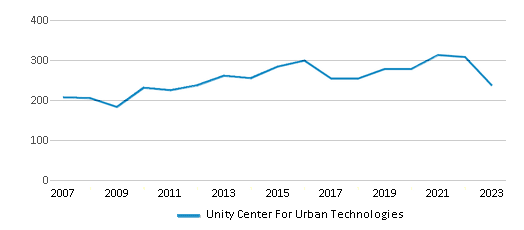
Gender %
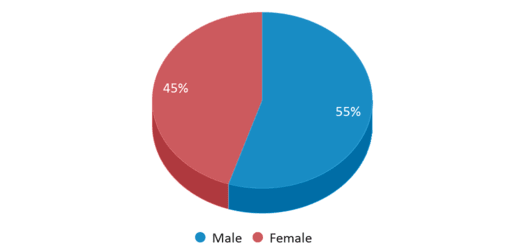
Total Classroom Teachers
20 teachers
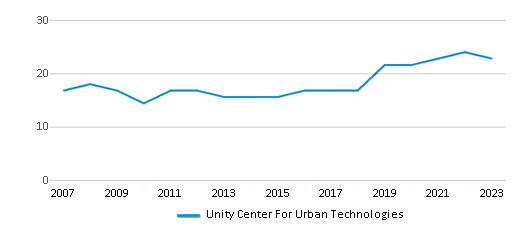
Students by Grade
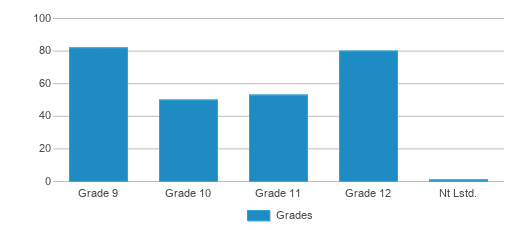
School Rankings
Unity Center For Urban Technologies ranks within the top 50% of all 4,377 schools in New York (based off of combined math and reading proficiency testing data).
The diversity score of Unity Center For Urban Technologies is 0.55, which is less than the diversity score at state average of 0.72. The school's diversity has stayed relatively flat over five school years.
Overall Testing Rank
#1941 out of 4377 schools
(Top 50%)
(Top 50%)
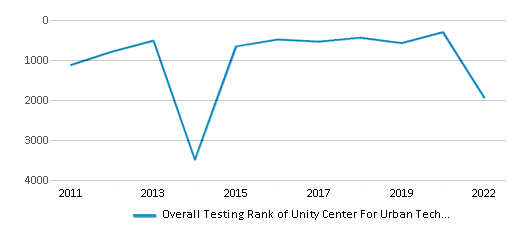
Math Test Scores (% Proficient)
85-89%
46%
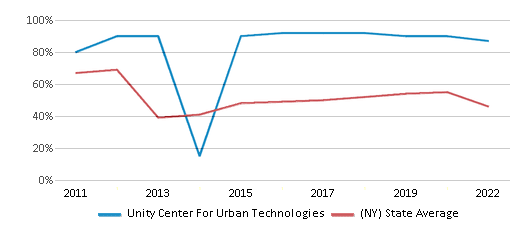
Reading/Language Arts Test Scores (% Proficient)
21-39%
49%
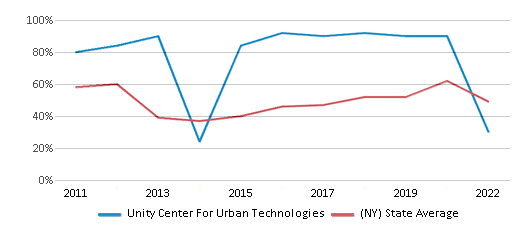
Science Test Scores (% Proficient)
≥95%
78%
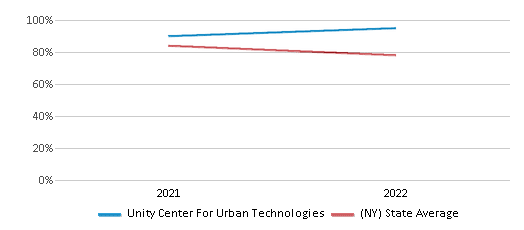
Student : Teacher Ratio
13:1
11:1

American Indian
2%
1%
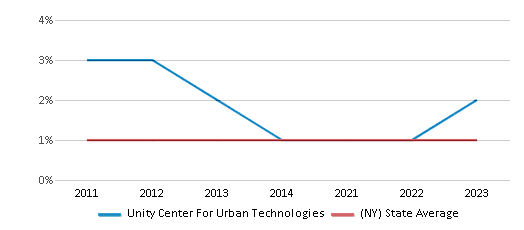
Asian
12%
10%
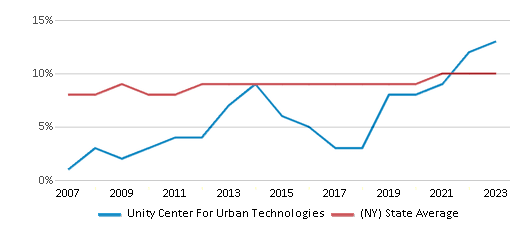
Hispanic
65%
30%
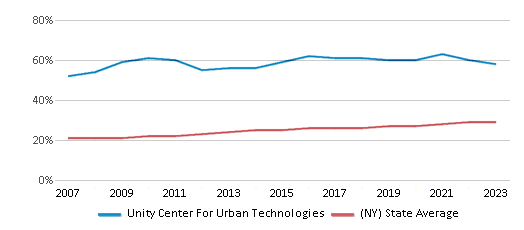
Black
12%
16%
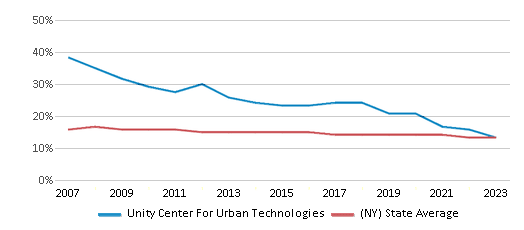
White
6%
40%
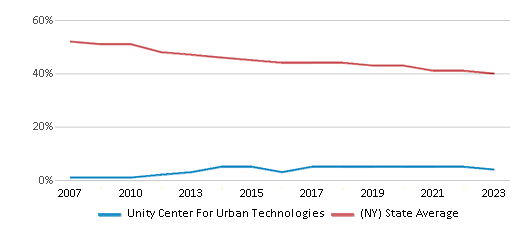
Hawaiian
1%
n/a
Two or more races
2%
3%
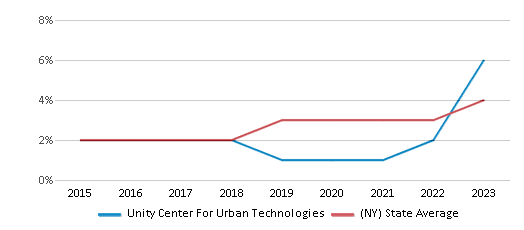
All Ethnic Groups
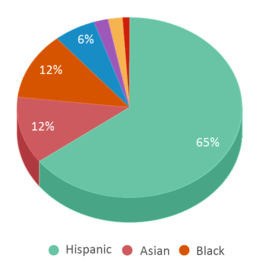
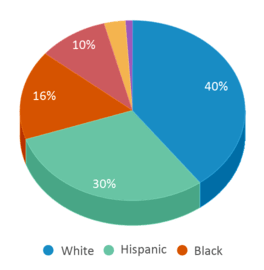

Graduation Rate
≥90%
87%
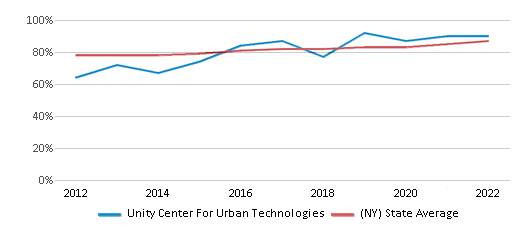
Participates in the National School Lunch Program (NSLP)
Yes
Eligible for Free Lunch
86%
54%
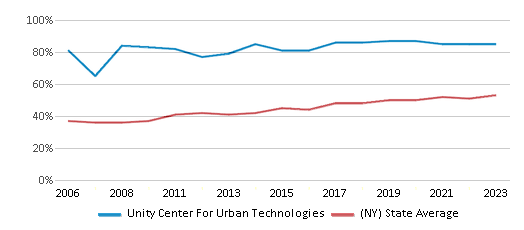
Eligible for Reduced Lunch
1%
3%
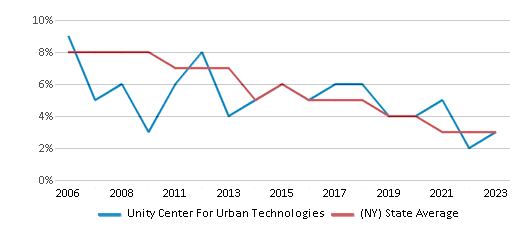
School Statewide Testing
School District Name
Source: National Center for Education Statistics (NCES), NY Dept. of Education
Profile last updated: 02/09/2025
Frequently Asked Questions
What is Unity Center For Urban Technologies's ranking?
Unity Center For Urban Technologies is ranked #1941 out of 4,377 schools, which ranks it among the top 50% of public schools in New York.
What percent of students have achieved state testing proficiency in math and reading?
85-89% of students have achieved math proficiency (compared to the 46% NY state average), while 21-39% of students have achieved reading proficiency (compared to the 49% NY state average).
What is the graduation rate of Unity Center For Urban Technologies?
The graduation rate of Unity Center For Urban Technologies is 90%, which is higher than the New York state average of 87%.
How many students attend Unity Center For Urban Technologies?
266 students attend Unity Center For Urban Technologies.
What is the racial composition of the student body?
65% of Unity Center For Urban Technologies students are Hispanic, 12% of students are Asian, 12% of students are Black, 6% of students are White, 2% of students are American Indian, 2% of students are Two or more races, and 1% of students are Hawaiian.
What is the student:teacher ratio of Unity Center For Urban Technologies?
Unity Center For Urban Technologies has a student ration of 13:1, which is higher than the New York state average of 11:1.
What grades does Unity Center For Urban Technologies offer ?
Unity Center For Urban Technologies offers enrollment in grades 9-12 (offers virtual instruction).
What school district is Unity Center For Urban Technologies part of?
Unity Center For Urban Technologies is part of New York City Geographic District # 2 School District.
School Reviews
5 9/8/2021
They did a great job with remote learning.
1 6/26/2021
My daughter was to be an upcoming freshman this fall. I don''t know much about the school so I called the school to get more info. I was transferred to the guidance counselor and was told to look online to get the info. Not so friendly. So I then emailed both the principal and assistant directly. One month later no response from neither. There is no way I am sending my daughter to a place like this. Parents, do your research before applying!
Review Unity Center For Urban Technologies. Reviews should be a few sentences in length. Please include any comments on:
- Quality of academic programs, teachers, and facilities
- Availability of music, art, sports and other extracurricular activities
Recent Articles

What Is A Charter School?
Explore the world of charter schools in this comprehensive guide. Learn about their history, how they operate, and the pros and cons of this educational innovation. Discover key facts about charter schools, including admission policies, demographics, and funding, as well as what to look for when considering a charter school for your child.

10 Reasons Why High School Sports Benefit Students
Discover the 10 compelling reasons why high school sports are beneficial for students. This comprehensive article explores how athletics enhance academic performance, foster personal growth, and develop crucial life skills. From improved fitness and time management to leadership development and community representation, learn why participating in high school sports can be a game-changer for students' overall success and well-being.

February 05, 2025
Understanding the U.S. Department of Education: Structure, Impact, and EvolutionWe explore how the Department of Education shapes American education, from its cabinet-level leadership to its impact on millions of students, written for general audiences seeking clarity on this vital institution.






